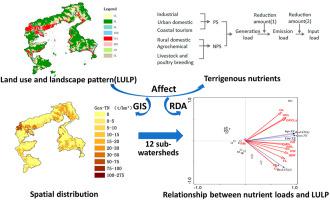Ocean & Coastal Management ( IF 4.8 ) Pub Date : 2021-03-04 , DOI: 10.1016/j.ocecoaman.2021.105573 Lanlan Xiong , Bingrou Xi , Yunchao Wu , Songlin Liu , Ling Zhang , Xiaoping Huang , Peter I. Macreadie

|
Eutrophication (excessive plant/algal growth caused by nutrient pollution) of coastal waters has increased globally and is associated with many ecological and environmental problems. In China, eutrophication is recognized as a key threat to sustainable economic development and human wellbeing. To address the eutrophication problem, the first step is to identify the sources and drivers of nutrient input. This, however, is challenging in densely populated areas of rapid land use and land cover change (LUCC) because there are so many potential sources of nutrient pollution. In this study, we sought to estimate nutrient pollution, determine drivers, and develop reduction strategies for Daya Bay, southeastern China's most densely populated and industrialized coastal region with a small watershed. We identified six key sources of total nitrogen (TN) and total phosphorus (TP) loading into Daya Bay. We developed spatially-explicit heat maps to guide resource managers to priority areas and demonstrate how different pollution generation and discharge characteristics are linked to land use and landscape pattern (LULP). We found that the generation, emission and input of terrigenous TN loads were 5863.7, 1975.3 and 1540.4 t yr−1, respectively, while those of TP were 762.2, 197.1 and 134.1 t yr−1, respectively. Urban domestic pollution loads (UDPL) were the main source of TN, while agrochemical pollution loads (APL) were the main source of TP. The Dan'ao River basin was the critical source region of TN loads, while the Baiyun-Zhuyuan River basin was the critical source region of TP loads. The area of urban construction lands (UCL) and rural residential lands (RRL) were the dominant factors controlling TN loads, while cultivated land (CL) and RRL controlled TP loads. Increasing green in shores (GS), inland water bodies (IWB) and coastal wetlands (CW) could effectively reduce the amount of TN flowing into the bay, while increasing forest land (FL), IWB, CW and GS were able to effectively reduce the amount of TP. These findings suggest that we could reduce the TN load entering Daya Bay by controlling the area of UCL, increasing GS and CW, protecting IWB in the critical source region of TN; and we could reduce the TP load through planting forest, protecting IWB, and restoring CW in the critical source region of TP. This study provides important new practical guidance on priority areas to combine control nutrients with ecological restoration in watershed-bay ecosystem management.











































 京公网安备 11010802027423号
京公网安备 11010802027423号